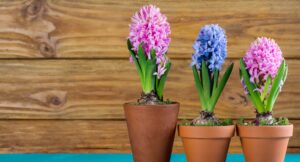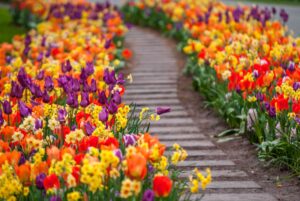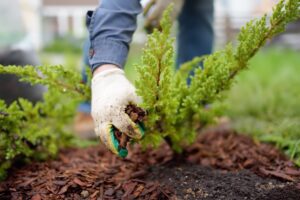Shrubs To Grow in Your Yard: 5 Beautiful Options for Any Landscape
Are you looking to enhance your yard’s appearance, create privacy, or add structure to your landscape? Shrubs might be exactly what you need. These versatile woody plants occupy the middle ground between perennials and trees, offering year-round interest and structure while requiring less maintenance than many other garden elements. Whether you have a sprawling suburban yard or a compact urban space, the right shrubs can transform your outdoor environment into a haven of beauty and functionality.
Why Shrubs Deserve a Place in Your Yard
Before we dive into specific recommendations, let’s explore why shrubs make such excellent additions to residential landscapes across America. Unlike annual flowers that need replanting every year, or high-maintenance specialty plants, shrubs offer lasting value with relatively modest care requirements.
Shrubs provide multiple benefits that can improve both the aesthetics and functionality of your outdoor spaces. They create visual anchors in garden beds, establish boundaries between different areas of your yard, and offer habitat for local wildlife. Many shrubs produce attractive flowers, berries, or fall foliage that add seasonal interest throughout the year. Additionally, certain varieties can help with erosion control on slopes or serve as windbreaks to protect more delicate plants.
According to the USDA Natural Resources Conservation Service, native shrubs in particular can help conserve water, reduce the need for fertilizers and pesticides, and support local ecosystems, making them an environmentally responsible choice for your landscape (USDA NRCS).
Understanding Your Growing Conditions
Before selecting shrubs for your yard, you need to assess several key factors that will determine which varieties will thrive in your specific conditions:
- Hardiness Zone: The USDA Plant Hardiness Zone Map divides North America into zones based on average annual minimum winter temperatures. Knowing your zone helps ensure you choose shrubs that can survive your winters. You can find your hardiness zone through the USDA’s interactive map at planthardiness.ars.usda.gov.
- Sun Exposure: Observe how much direct sunlight different areas of your yard receive throughout the day. Categories typically include full sun (6+ hours), partial sun/partial shade (4-6 hours), and full shade (less than 4 hours).
- Soil Type and pH: Most shrubs prefer well-draining soil, but specific preferences vary. Conducting a simple soil test can help determine your soil’s texture (sandy, loamy, or clay) and pH level (acidic, neutral, or alkaline).
- Available Space: Consider both the width and height your shrub will reach at maturity. Planting a potentially large shrub in a confined space will lead to constant pruning or eventual removal.
- Purpose: Are you looking for privacy screening, wildlife attraction, seasonal color, or structural elements? Clarifying your goals will help narrow your choices.
Now that we’ve covered the groundwork, let’s explore five exceptional shrubs that can thrive in American yards, each offering unique benefits and characteristics.
5 Outstanding Shrubs for American Yards
1. Hydrangea (Hydrangea macrophylla)
Few shrubs can match the showstopping blooms of hydrangeas, which have captured the hearts of American gardeners for generations. These versatile shrubs produce large, showy flower clusters that can transform the look of your landscape from summer through fall.
Growing Requirements and Characteristics
Hydrangeas thrive in morning sun with afternoon shade in most regions, though in northern areas they can tolerate more sun if provided with consistent moisture. They prefer rich, well-draining soil with regular watering, especially during dry spells. What makes hydrangeas particularly fascinating is how some varieties (particularly the bigleaf types) can change flower color based on soil pH—blue in acidic soil and pink in alkaline conditions.
Most hydrangea varieties grow between 3-6 feet tall and wide, making them suitable for foundation plantings, mixed borders, or as specimen plants. While they’re known for their dramatic flowers, many hydrangeas also offer attractive foliage and interesting branch structure during winter.
Best Varieties to Consider
- Endless Summer: A revolutionary bigleaf hydrangea that blooms on both old and new wood, ensuring flowers even after harsh winters
- Limelight: Features cone-shaped, lime-green flowers that age to pink and burgundy
- Annabelle: Produces enormous white flower heads that remain attractive even as they fade
- Oakleaf Hydrangea: Offers beautiful fall foliage in addition to white flower clusters
Maintenance Tips
Hydrangeas require relatively minimal maintenance once established. Pruning needs vary by type—some bloom on old wood (last year’s growth), others on new wood (current year’s growth), and some on both. For most varieties, you’ll want to remove dead wood in early spring and prune after flowering if needed to control size. Mulching around the base helps retain moisture and moderate soil temperature.

2. Boxwood (Buxus spp.)
When it comes to versatility and classic appeal, few shrubs can match boxwood. These evergreen shrubs have defined American gardens for centuries, from Colonial-era formal gardens to modern minimalist landscapes.
Growing Requirements and Characteristics
Boxwoods are adaptable shrubs that can grow in full sun to partial shade, though they often appreciate afternoon shade in hotter regions. They prefer well-draining soil with consistent moisture but can tolerate brief drought once established. Most varieties are hardy from USDA zones 5-9, though specific cold hardiness varies by cultivar.
What makes boxwoods particularly valuable is their dense, fine-textured evergreen foliage that responds well to pruning. This makes them ideal for formal hedges, topiaries, or structured garden elements. Their size ranges from compact varieties that stay under 2 feet to larger types that can reach 8-10 feet tall if left unpruned.
Best Varieties to Consider
- Wintergreen (Buxus sinica var. insularis ‘Wintergreen’): Offers excellent cold hardiness and maintains good green color through winter
- Green Velvet: Features a naturally rounded form requiring minimal shaping
- Green Mountain: Grows in a natural conical shape, good for vertical accent
- Little Missy: A compact variety perfect for small spaces
Maintenance Tips
While boxwoods are relatively low-maintenance, they benefit from proper care to stay healthy and attractive. Regular light pruning helps maintain desired shape and encourages dense growth. However, avoid heavy pruning in fall, as new growth may not harden off before winter. Boxwoods can be susceptible to several pests and diseases, including boxwood blight, so good air circulation and avoiding overhead watering are important preventive measures.
The National Park Service provides valuable information on historic boxwood gardens and their maintenance at sites like Colonial Williamsburg, which can offer inspiration for your own landscape design (NPS Historic Landscapes).
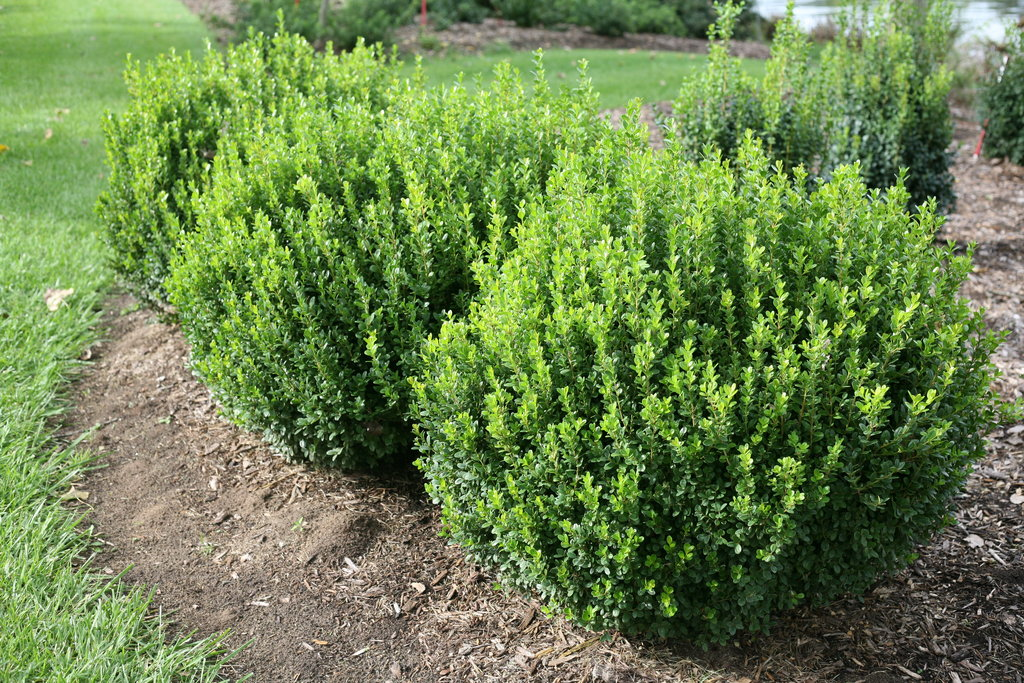
3. Ninebark (Physocarpus opulifolius)
If you’re looking for a native shrub that offers multiple seasons of interest with outstanding durability, ninebark deserves your attention. This North American native has gained popularity in recent years for its colorful foliage, interesting bark, and adaptability to various growing conditions.
Growing Requirements and Characteristics
Ninebark thrives in full sun to partial shade and adapts to a wide range of soil conditions, including clay. It’s drought-tolerant once established and remarkably resistant to both disease and pest problems. Hardy from USDA zones 3-8, ninebark can handle cold winters and hot summers with equal resilience.
Most ninebark varieties grow 5-10 feet tall and wide, though compact cultivars are available for smaller spaces. The shrub gets its name from its exfoliating bark, which peels in layers, creating winter interest. Beyond the bark, ninebark offers three-season appeal with colorful foliage (in red, purple, or gold depending on variety), white to pink spring flowers, and red fruit clusters in summer.
Best Varieties to Consider
- Diablo: Features deep purple-burgundy foliage that provides dramatic contrast in the landscape
- Amber Jubilee: Displays foliage in shades of orange, yellow, and gold
- Little Devil: A compact variety (3-4 feet) with purple foliage, perfect for smaller yards
- Summer Wine: Offers wine-red foliage on a compact form with arching branches
Maintenance Tips
One of ninebark’s greatest assets is its minimal maintenance requirements. It needs little pruning except to remove dead or damaged branches, though you can prune after flowering to control size if needed. While it’s drought-tolerant once established, providing consistent moisture during the first year helps develop a strong root system.
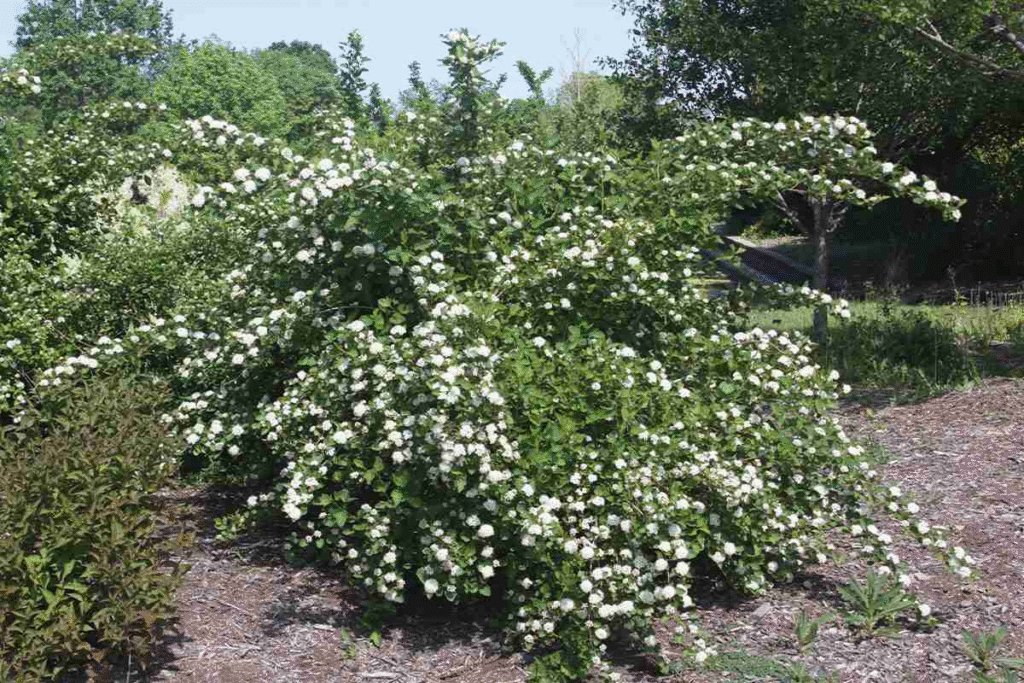
4. Japanese Spirea (Spiraea japonica)
For gardeners seeking a compact, flowering shrub that provides multiple seasons of interest without demanding intensive care, Japanese spirea offers an excellent solution. These deciduous shrubs pack a lot of ornamental value into a manageable size.
Growing Requirements and Characteristics
Japanese spireas perform best in full sun, where they’ll produce the most abundant flowers and most vibrant foliage colors. They prefer well-draining soil with moderate moisture but can tolerate a range of soil conditions. Hardy in USDA zones 4-8, these adaptable shrubs can thrive in most parts of the continental United States.
Most cultivars remain relatively compact, typically reaching 2-4 feet in height and width, making them perfect for smaller gardens or as front-of-border plants in larger landscapes. Their mounded growth habit creates an attractive natural form that works well in both formal and informal garden settings.
Japanese spireas offer seasonal interest starting with colorful new foliage in spring (often gold, burgundy, or coppery-red depending on the variety), followed by clusters of pink or white flowers in late spring to summer. Many varieties will produce a second flush of blooms if deadheaded after the first flowering period.
Best Varieties to Consider
- Magic Carpet: Features bright golden-yellow foliage with red tips and pink flowers
- Double Play Gold: Offers bright gold foliage and vibrant pink blooms
- Shirobana: Displays unique white, pink, and red flowers all on the same plant
- Little Princess: A compact variety with bright pink flowers and good drought tolerance
Maintenance Tips
Japanese spireas respond well to regular pruning, which promotes denser growth and more abundant flowering. Pruning in early spring before new growth emerges helps maintain the desired size and shape. Deadheading spent flowers can encourage additional blooming periods. While established plants have moderate drought tolerance, consistent moisture produces better flowering and foliage display.
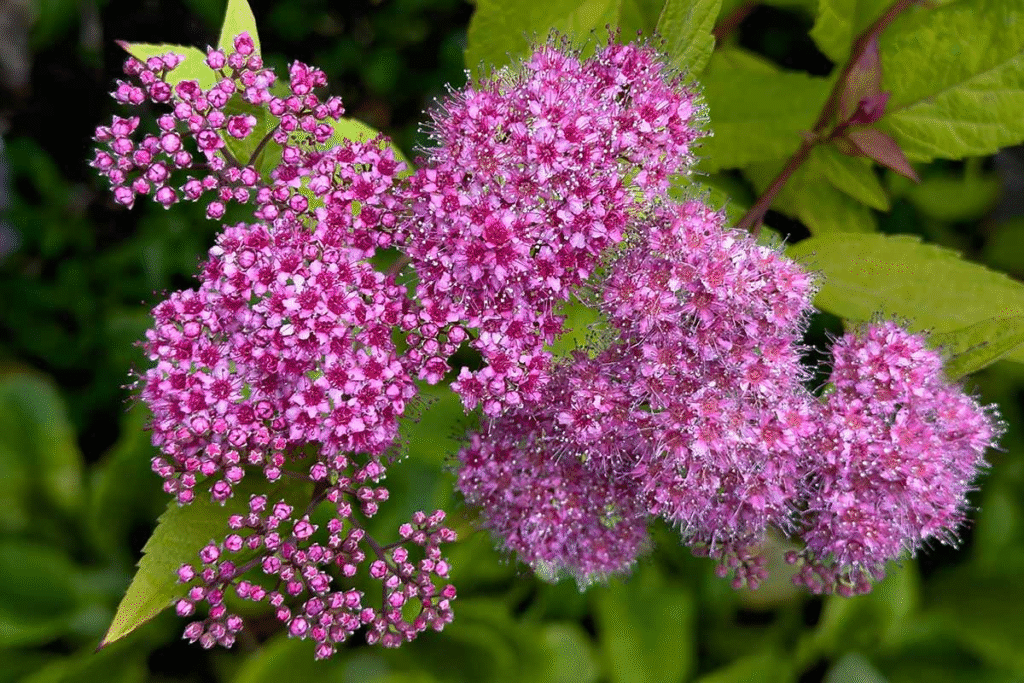
5. Viburnum (Viburnum spp.)
Rounding out our top five shrubs is the diverse viburnum genus, which includes numerous species and cultivars that can satisfy almost any landscape need. From impressive flowers to colorful berries and fall foliage, viburnums offer multi-season interest with relatively low maintenance requirements.
Growing Requirements and Characteristics
Most viburnums prefer full sun to partial shade, with some varieties tolerating more shade than others. They generally prefer moist, well-draining soil with moderate fertility, though adaptation varies by species. The hardiness range is broad across the genus, with options suitable for USDA zones 2-9 depending on the specific variety.
Viburnums range dramatically in size, from compact 2-3 foot varieties to small tree-like specimens reaching 15-20 feet. This diversity makes them suitable for everything from mixed borders to privacy screens or specimen plantings. Many viburnums feature fragrant flowers in spring, followed by berries that transition through various colors before reaching maturity. Several species also offer outstanding fall foliage colors.
Best Varieties to Consider
- Korean Spice (V. carlesii): Produces intensely fragrant flowers in spring
- Arrowwood (V. dentatum): A tough native species with blue berries and red-purple fall color
- Doublefile (V. plicatum f. tomentosum): Features horizontal branching with flowers displayed along the branches
- Blackhaw (V. prunifolium): A native species that can be grown as a large shrub or small tree
Maintenance Tips
Most viburnums require minimal pruning except to remove dead or damaged branches, though they can be pruned after flowering to control size or shape if needed. For varieties grown for their berries, remember that some require cross-pollination with a different cultivar of the same species to produce fruit. Applying a layer of mulch helps maintain soil moisture and temperature.
The U.S. Forest Service provides detailed information on native viburnum species and their ecological benefits at their Native Plant Database.

Comparison of Recommended Shrubs
To help you choose which shrubs might work best for your specific situation, here’s a comparative overview of our five recommended shrubs:
| Shrub | USDA Hardiness Zones | Size Range (H×W) | Light Requirements | Special Features | Maintenance Level |
|---|---|---|---|---|---|
| Hydrangea | 3-9 | 3-6′ × 3-6′ | Part sun/part shade | Showy flowers, some change color with soil pH | Moderate |
| Boxwood | 5-9 | 2-10′ × 2-8′ | Sun to part shade | Evergreen, formal structure, responds well to pruning | Moderate to High |
| Ninebark | 3-8 | 5-10′ × 5-10′ | Full sun to part shade | Colorful foliage, exfoliating bark, native | Low |
| Japanese Spirea | 4-8 | 2-4′ × 2-4′ | Full sun | Colorful foliage, repeated blooming | Low to Moderate |
| Viburnum | 2-9 | 2-15′ × 2-15′ | Sun to part shade | Fragrant flowers, berries, fall color | Low |
Planting and Establishment Tips
Now that you’ve selected the perfect shrubs for your yard, proper planting and establishment are crucial for their long-term success. Follow these guidelines to give your new shrubs the best possible start:
When to Plant
In most regions of the United States, fall is the ideal time to plant shrubs. The soil is still warm enough to encourage root growth, while cooler air temperatures reduce stress on the plant. Spring is the second-best option, particularly in areas with extremely cold winters. Avoid planting during the heat of summer unless absolutely necessary.
Planting Process
- Dig appropriately: Create a planting hole that’s twice as wide as the root ball but no deeper than the root ball’s height. This encourages roots to spread outward into surrounding soil.
- Examine the roots: For container-grown shrubs, gently loosen any circling roots before planting. For balled-and-burlapped plants, remove any wire cages, strings, or synthetic burlap after placing the root ball in the hole.
- Position correctly: Set the shrub in the hole so that the top of the root ball is level with or slightly above the surrounding soil surface. Never plant too deeply, as this can cause root suffocation.
- Backfill carefully: Return the native soil to the hole, gently firming (not compacting) as you go. Creating a slight basin around the shrub helps direct water to the roots.
- Water thoroughly: After planting, water deeply to eliminate air pockets and settle the soil around the roots.
- Apply mulch: Add 2-3 inches of organic mulch around the shrub, keeping it a few inches away from the stems to prevent rot and rodent damage.
First-Year Care
The first year after planting is critical for establishing shrubs in their new location. During this period:
- Water consistently: Provide deep, infrequent watering rather than frequent shallow watering. In general, newly planted shrubs need about 1 inch of water per week, either from rainfall or irrigation.
- Monitor closely: Watch for signs of stress like wilting, yellowing leaves, or unusual leaf drop, which may indicate watering issues or transplant shock.
- Avoid fertilizing: Most newly planted shrubs don’t need fertilizer during their first growing season. Fertilizers can stimulate top growth at the expense of root development, which is the priority during establishment.
- Limit pruning: Restrict pruning to removal of damaged or dead branches only. Heavy pruning creates additional stress on new plants.
Long-Term Maintenance Strategies
After your shrubs have become established in your landscape, implementing good maintenance practices will keep them healthy and attractive for years to come.
Watering
Established shrubs generally need supplemental water only during extended dry periods. When watering is necessary, apply water slowly and deeply to encourage deep root development. Soaker hoses or drip irrigation systems are ideal for shrubs as they deliver water directly to the root zone while keeping foliage dry, which helps prevent disease issues.
Mulching
Refreshing the mulch layer around your shrubs annually offers multiple benefits: it conserves soil moisture, moderates soil temperature, suppresses weeds, and adds organic matter to the soil as it breaks down. Maintain a 2-3 inch layer, remembering to keep mulch pulled back from direct contact with stems.
Pruning
Different shrubs have different pruning requirements based on their growth habits and flowering patterns. As a general rule:
- Prune spring-flowering shrubs (like many viburnums) shortly after they finish blooming
- Prune summer-flowering shrubs (like hydrangeas that bloom on new wood) in early spring
- Prune evergreens (like boxwood) in late spring or early summer
Always remove dead, diseased, or damaged branches whenever you notice them, regardless of season.
Fertilizing
Most established shrubs in average garden soil need minimal supplemental fertilization. When needed, apply a balanced slow-release shrub fertilizer in early spring according to package directions. Over-fertilization can lead to excessive growth that’s more susceptible to pests and diseases.
Conclusion
Incorporating well-chosen shrubs into your yard creates lasting beauty and structure with relatively modest maintenance requirements. The five outstanding shrubs we’ve explored—hydrangea, boxwood, ninebark, Japanese spirea, and viburnum—offer options suitable for virtually any American landscape, from traditional to contemporary.
Remember that the key to success with shrubs lies in matching the right plant to the right place in your yard. By considering your specific growing conditions, space constraints, and aesthetic preferences, you can select shrubs that will thrive with minimal intervention while providing maximum enjoyment.
For more information on selecting and caring for shrubs appropriate for your specific region, the USDA’s Cooperative Extension System offers localized gardening advice through offices in nearly every county in the United States. You can find your local extension office at nifa.usda.gov/land-grant-colleges-and-universities-partner-website-directory.
With thoughtful selection and proper care, the shrubs you plant today will enhance your yard’s beauty, functionality, and ecological value for many years to come.


